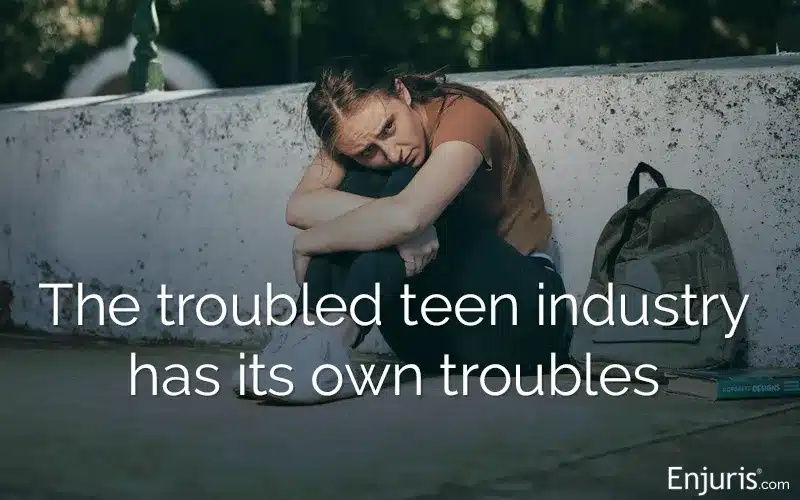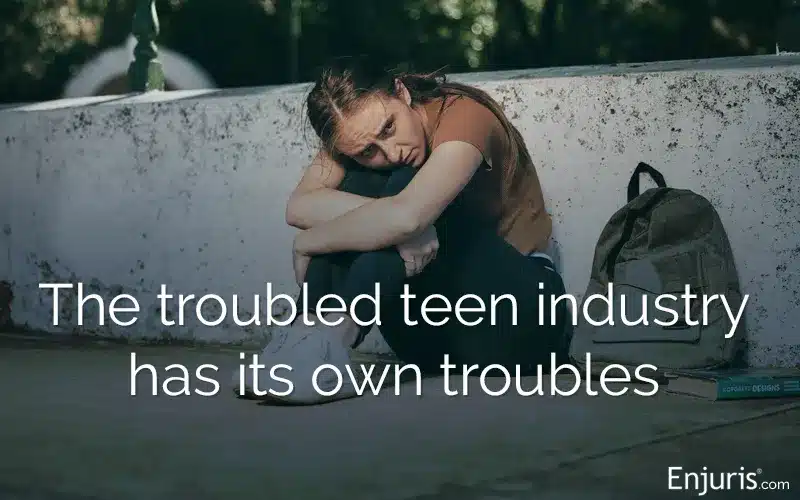[ad_1]

The people entrusted to care for troubled teens are sometimes creating new and different problems
The troubled teen industry is booming. But that’s not good news, especially when corruption, abuse, and neglect runs rampant in these for-profit businesses.
Teenagers, amiright?
If you’re a parent of a teen, you’ve endured your share of side-eye, foot-stomping, slammed doors, and condescending comments. Every teen does it.
But teen angst isn’t a joke for a lot of families. A whole set of businesses has arisen that characterize the “troubled teen industry.” However, in facilities and homes that should be a safe refuge for a troubled teen, there are instances of assault, abuse, and sometimes deaths.
What is the troubled teen industry?
These are for-profit behavioral treatment programs, schools and facilities designed to help teenagers who are experiencing a variety of behavioral, emotional, or psychological issues. These issues can range from substance abuse and mental health disorders to behavioral problems like defiance, aggression, or poor academic performance.
There are several types of programs that are included within this industry:
- Residential treatment centers (RTCs): These are live-in facilities that provide therapy and education to troubled teens. The treatment often includes a mix of individual and group therapy, academic schooling, and sometimes behavior modification techniques.
- Therapeutic boarding schools: Similar to RTCs but with a stronger focus on education, these schools offer therapy alongside a structured academic curriculum.
- Wilderness therapy programs: These programs use outdoor experiences as a form of behavior therapy. They often include survival skills, hiking, and camping, with the aim of building self-esteem and responsibility through outdoor challenges.
- Boot camps: Modeled after military training camps, these programs use strict discipline and physical conditioning to address behavioral issues.
There are a few reasons why the troubled teen industry is… troubled.
First, they tend to be for-profit businesses, which means these entities are prioritizing profit over the teens’ well-being. Second, there is a lack of regulation and oversight. These factors lend themselves to environments where abuse and mistreatment occur. Critics call for better regulation, oversight, and accountability to ensure the safety and well-being of the teenagers enrolled in these programs.
Types of abuse in teen facilities
- Physical abuse, sometimes used for control or punishment. This could include incidents of punching, dragging, throwing, or slamming children against the floor or walls.
- Emotional abuse could be persistent verbal abuse, yelling, cursing, insulting, and humiliating in front of other patients.
- Sexual abuse happens, committed both by facility staff and other teens at the facilities.
- Restraint and seclusion can result in injury and sometimes death.
- Overuse and misuse of psychiatric medication can pose life-threatening risks.
- Poorly maintained facilities can mean inadequate access to clean water, as well as poor sanitation and bedding.
Lawsuits regarding teen treatment centers
Most lawsuits against teen treatment centers are claims of negligence, recklessness, false advertising and medical malpractice.
Los Niños Academy lawsuit
Los Niños Academy was a treatment center for boys in the Albuquerque, New Mexico area. Three boys between the ages of 8 and 15 years old filed a lawsuit, claiming that they suffered abuse including being forced to run laps as a form of punishment, being denied water while running, and sexual abuse.
Defendants in the lawsuit are Los Niños Academy and its operator, Youth Health Associates. The latter operates six other treatment facilities. The facility was later closed and children were removed to other placements.
Lord’s Ranch lawsuit
The Lord’s Ranch youth treatment center, which closed in 2016 after its owner was convicted of a bribery scheme, is being sued by eight former residents. These lawsuits claim that the owners and operators of the Arkansas facility routinely and systematically abused the children who lived there.
The ranch was in a remote environment and the children felt alone and far from home; the lawsuits claim that children were raped and sexually abused and that the staff were sadistic. There are also allegations that the operators threatened victims or others who spoke out about the abuses occurring within.
Attorneys representing the plaintiffs say there are also at least 30 additional victims who claim to have been abused at the facility.
Lifeline Youth & Family Services/Lasting Change lawsuit
A Tuskegee residential treatment center is named as a defendant in a lawsuit against parent company Sequel TSI. The plaintiff is the representative of a 15-year-old boy called “G.P.” The boy claims to have endured sexual, physical and verbal abuse from staff and teen residents at the facility. He reported a particular incident that happened early in his stay at the facility, and employees did not protect him from retaliation. He was subject to bullying and assaults daily and the employees were negligent in ensuring his safety. G.P. suffered black eyes, bloody noses, bites, and other injuries. He also attempted suicide during his time at the treatment center. The lawsuit alleges that the staff did not take him to the hospital until the following day.
Four other lawsuits have been filed with similar allegations of abuse.
Alabama Clinical Schools lawsuit
Attorneys for an 11-year-old boy filed a lawsuit against a residential behavioral facility in Birmingham. It claims that the child experienced continuous physical, verbal and emotional abuse and that the staff threatened to kill him if he reported it. The child also was bitten by scorpions in his bed. In 2022, he was assaulted by a staffer and suffered shoulder injuries and a broken collarbone. A few days later, he was assaulted in the head, face and neck by an employee of the center. A few months later, he endured another assault by an employee who kicked and stomped him in the stomach and face.
What to do if your child is a victim
A parent wouldn’t place a child in inpatient treatment unless it’s truly warranted. A child in crisis needs help, and it’s always the right decision to seek professional help. The best way to find treatment is to ask for a referral from a trusted physician, like your child’s pediatrician or psychiatrist.
However, if you believe that your child has suffered harm in a behavioral treatment facility, the first thing to do is to remove your child and ensure that they are relocated to a safe space. Next, you might wish to make a report to your state’s child protection agency. If you need to file a lawsuit, you should contact a personal injury lawyer for guidance.
Tell your story:
[ad_2]



